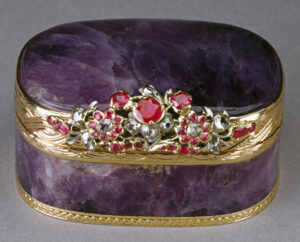
Snuff-taking. Sounds odd now, doesn’t it? But back in the Regency era, it was the height of fashion—something that both gentlemen and ladies indulged in with flair. Today, most people wouldn’t even recognize a snuffbox if they saw one, but in the early 1800s, it was practically a must-have accessory for anyone wanting to seem refined, worldly, or just a little bit rebellious.
Where Did Snuff Come From?
Snuff—a finely ground powder made from tobacco—made its way to Europe way back in the 1500s. But it wasn’t until the 1700s and early 1800s that it really took off in high society. By the time of the Regency, it was everywhere. And it wasn’t just plain old tobacco—snuff came scented with lavender, rose, cinnamon, or all sorts of other lovely things. A bit less harsh than smoking, and a lot more elegant (at least, in theory).
The Snuff-Taking Ritual

Now, taking snuff wasn’t just a matter of sniff and go. Oh no—it was practically a performance. You’d tap a tiny pinch of it from your fancy snuffbox onto the back of your hand, then inhale it gently through the nose. Doing it with too much gusto and ending up in a sneezing fit? Embarrassing. The goal was elegance, always.
And the snuffboxes? Little treasures in their own right. Made of gold, silver, enamel, even tortoiseshell, and often decorated with exquisite designs. Some were so ornate they’d be the talk of the room all by themselves. Owning a really fine snuffbox was as much a status symbol as owning a carriage or wearing the latest French fashion.
It Was a Social Thing, Too
Like so many habits of the time, snuff-taking was something people did together. Offering someone a pinch of your best blend was a gesture of goodwill, and often a way to strike up conversation. At the same time, it showed you were in the know—sophisticated, fashionable, and maybe just a touch daring.
Of course, not everyone was a fan. Some people thought it was a bit uncouth (especially for women), and there were murmurs about it being unhealthy (which, in hindsight… fair). But that didn’t stop the trend. Some snuffboxes even carried political symbols—yes, really! People would align themselves with certain factions and quite literally wear their loyalties in their pocket.
The Beginning of the End
By the mid-1800s, though, snuff’s popularity started to wane. Cigars and cigarettes were on the rise, and attitudes toward tobacco were shifting. Slowly but surely, snuff-taking began to seem old-fashioned, like powdered wigs or fans used for flirting.
A Lost Habit
These days, snuff-taking is one of those quirky little historical footnotes—something you might see in a museum, or in a period drama, but rarely hear about otherwise.
Still, it’s a fascinating peek into Regency life—where elegance mattered, little rituals spoke volumes, and even something as simple as a sneeze could make or break your social moment.
References for Further Reading:
- A Pinch of Prestige: Regency Snuff
https://randombitsoffascination.com/2025/05/27/a-pinch-of-prestige-regency-snuff/ - The Stuff of Snuff: The Affective and Sensory Connotations of Snuffboxes in Eighteenth-Century Culture
https://brill.com/view/journals/ehcs/7/1/article-p95_7.xml

Leave a Reply